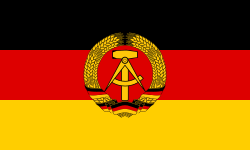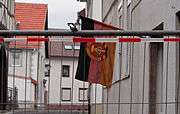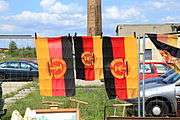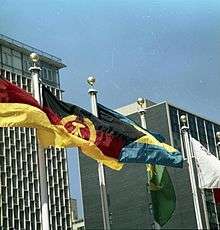Flag of East Germany
The flag of East Germany was the official national flag of the German Democratic Republic (East Germany) during its existence from 1949 to 1990. The flag's design and symbolism are derived from the flag of the Weimar Republic and communist symbolism. The flag was outlawed as an unconstitutional and criminal symbol in West Germany and West Berlin, where it was referred to as the Spalterflagge (secessionist flag) until the late 1960s.
 | |
| Name | Flagge der Deutschen Demokratischen Republik |
|---|---|
| Use | National flag and ensign |
| Proportion | 3:5 |
| Adopted | 1 October 1959 |
| Relinquished | 1990 (unification) |
| Design | A horizontal tricolour of black, red, and gold, adorned with the National Emblem of East Germany. |
Symbolism and design
With relations deteriorating between the Soviet Union and the United States, the three western Allies met in March 1948 to merge their zones of occupation and allow the formation of what became the Federal Republic of Germany, commonly known as West Germany. Meanwhile, the eastern Soviet zone became the German Democratic Republic, commonly known as East Germany. During the preparation of the new constitution for West Germany, discussions regarding its national symbols took place in August 1948 during a meeting at Herrenchiemsee. Although there were objections to the creation of a national flag before reunification with the east, it was decided to proceed. This decision was primarily motivated by the proposed constitution by the eastern SED in November 1946,[1] where black-red-gold were suggested as the colours for a future German republic.[2]
While there were other suggestions for the new flag for West Germany,[3] the final choice was between two designs, both using black-red-gold. The Social Democrats proposed the re-introduction of the old Weimar flag, while the conservative parties such as the CDU/CSU and the German Party proposed a suggestion by Ernst Wirmer, a member of the Parlamentarischer Rat (parliamentary council) and future advisor of chancellor Konrad Adenauer. Wirmer suggested a variant of the 1944 "Resistance" flag (using the black-red-gold scheme in a Nordic Cross pattern) designed by his brother and 20 July co-conspirator Josef.[4] The tricolour was ultimately selected, largely to illustrate the continuity between the Weimar Republic and this new German state. With the enactment of the (West) German constitution on 23 May 1949, the black-red-gold tricolour was adopted as the flag for the Federal Republic of Germany.
In 1955, the inhabitants of the French-administered Saar Protectorate voted to join West Germany.[5] Since its establishment as a separate French protectorate in 1947, the Saar had a white Nordic cross on a blue and red background as its flag.[6] To demonstrate the commitment of the Saar to be a part of West Germany, a new flag was selected on 9 July 1956: the black-red-gold tricolour defaced with the new coat of arms, also proposed on this day.[7] This flag came into force on 1 January 1957, upon the establishment of the Saarland as a state of West Germany.
While the use of black-red-gold had been suggested in the Soviet zone in 1946, the Second People's Congress in 1948 decided to adopt the old black-white-red tricolour as a national flag for East Germany. This choice was based on the use of these colours by the National Committee for a Free Germany,[3] a German anti-Nazi organisation that operated in the Soviet Union in the last two years of the war. In 1949, following a suggestion from Friedrich Ebert Jr., the black-red-gold tricolour was instead selected as the flag of the German Democratic Republic upon the formation of this state on 7 October 1949.[8] From 1949 to 1959, the flags of both West and East Germany were identical. On 1 October 1959, the East German government changed its flag with the addition of coat of arms.[9] In West Germany, these changes were seen as a deliberate attempt to divide the two Germanies. Displaying this flag in West Germany and West Berlin—where it became known as the Spalterflagge (divider-flag)—was seen as a breach of the constitution and subsequently banned until the late 1960s.
| Colour scheme | Black | Red | Gold | |||
|---|---|---|---|---|---|---|
| RAL | 9005 Jet black |
3020 Traffic red |
1021 Rapeseed yellow | |||
| HKS | 0, 0, 0 | 5.0PB 3.0/12 | 6.0R 4.5/14 | |||
| Pantone | Black | 485 | 7405* | |||
Colours scheme: valid for East German flags 1949-1990
The colours video approximation is listed below:[10]
| Black (flag/arms) |
Red (flag/arms) |
Gold (flag) |
Gold (arms) | |
|---|---|---|---|---|
| RGB | 0/0/0 | 221/0/0 | 255/206/0 | 255/199/9 |
| Hexadecimal | #000000ff | #dd0000ff | #ffce00ff | #ffc709ff |
| CMYK | 0/0/0/100 | 0/100/100/13 | 0/19/100/0 | 0/22/96/0 |
| HSL | 0/0/0 | 0/255/100 | 34/255/128 | 33/255/132 |
From 1956 to 1964, West and East Germany attended the Winter and Summer Olympic Games as a single team, known as the United Team of Germany. After the East German national flag was changed in 1959, neither country accepted the flag of the other. As a compromise, a new flag was used by the United Team of Germany from 1960 to 1964, featuring the black-red-gold tricolour defaced with white Olympic rings in the red stripe. In 1968 the teams from the two German states entered separately, but both used the same German Olympic flag. From 1972 to 1988, the separate West and East German teams used their respective national flags.
History
On the centenary of the Berlin March days in March 1948, the second People's Congress was convened in Berlin. It should be seen as German People's Council on the reorganization of the entire state in addition to the drafting of a constitution creating a national flag for the state of the German Democratic Republic. The choice was between three flags, one red, another black-white-red, and the last option black-red-gold. The proposal to introduce the red flag, was quickly discarded. As a sign of communist and the international labor movement this flag was rejected even during the November Revolution of 1918 (and beyond) by the bourgeoisie. As in Germany, the decision should fall in favor of the black, red and gold flag of the Weimar Republic. The Soviet Union was initially against this flag. As a symbol of the Weimar Republic they remember times of weakness, to crises and unemployment. Thus, the black-white-red flag remained. It goes back to the National Committee for a Free Germany. The committee was established on 12 and 13 June 1943 under Soviet leadership took the old Reich flag. The flag should be seen as signs of the struggle against the fascist Nazi regime are evaluated in Adolf Hitler and the swastika flag.
The Third People's Congress 1949, set up by the Soviet occupation in 1948, brought Mayor of East Berlin Friedrich Ebert yet again, and the proposal for the black-red-gold flag. His application was approved on 30 May 1949 and put into effect on 7 October 1949 Law on state emblem and flag from 26 September 1949.
Thus, the West (FRG) and East Germany (GDR) had the same national flag. The East, however, led only in the first ten years of its existence. During this time the FRG competed in color with the identical design of the GDR. On 1 October 1959[11] the GDR added their national emblem, "hammer and compass surrounded by a garland of corn" in the flag as so as to create a distinction to the flag of the Federal Republic. The emblem was a symbol of the alliance of between workers, farmers, and intelligentsia.
The public presentation of this officially as a "Soviet zone flag" designated by the FRG flag was, however, viewed by the end of the 1960s as a breach of the Constitution and disruption of public order in the FRG and West Berlin and basically prevented by police action. Even when hoisting the flag of the GDR abroad there were stereotyped to West German protests. It was only on 22 July 1969 ordered the federal government (Grand Coalition), that the police everywhere should take more action against the use of the flag and coat of arms of the GDR.
Since the GDR had not yet been recognized under international law, it started to be in 1968 in sporting contests, such as in Olympic Games, teams with athletes from both parts of Germany. The Olympic Committee of the GDR refused to compete under the flag of the Federal Republic, and the Olympic Committee of Germany lasted until the very last moment on, no changes in the black-red-gold flag carry. Ultimately yet succeeded yet an agreement. They sat on the red stripes of black, red and gold flag of the Olympic rings in white. As part of the international recognition of the GDR by the United Nations and the recognition of the sovereignty of the GDR by the FRG, two separate teams with two separate flags took part since the 1972 Winter Olympics.
With the introduction of the new national flag in 1959 a new merchant flag was introduced.[12] Before the GDR led the black-red-gold flag without coat of arms as merchant flag. The new merchant flag to a smaller state emblem is in the upper corner. 1973 this merchant flag was again abolished and replaced by the national flag, the order was National and merchant flag.
After the political turning point in 1989 in the GDR drew up the working group "New Constitution of the GDR," the Round Table a new constitution [13] and proposed a new national flag. They should continue to be striped black-red-golden, but show instead of the State Emblem the presentation of the motto Swords to ploughshares.[14] The other political events with the reunification ending existence of the GDR did not let the Constitution and therefore the new flag to take effect.
Historical flags
| Flag | Date | Use | Description |
|---|---|---|---|
 | 1949–1959 | State flag (Staatsflagge) | |
 | 1959–1990 | State flag (Staatsflagge) 1959–1990 Merchant flag (Handelsflagge) 1973–1990 | Tricolour of black, red, and yellow (same as West German colours), but bears the coat of arms of East Germany, consisting of a compass and a hammer encircled with rye |
.svg.png) | 1959–1973 | Merchant flag (Handelsflagge) | |
.svg.png) .svg.png) | 1963–1990 | Hanging state flag (Bannerflagge) | Both variants with vertical and horizontal bars were used. |
.svg.png) | 1955–1973 | Flag of East German Post | |
.svg.png) | 1975–1990 | Flag of East German Post | |
.svg.png) | 1955–1960 | Standard of the President | |
 | 1960–1990 | Standard of President of State Council | |
.svg.png) | 1960–1990 | Flag of the National People's Army (Nationale Volksarmee or NVA) | |
.svg.png) | 1960–1990 | Regimental colours (Truppenfahne) of Nationale Volksarmee | |
.svg.png) | 1960–1990 | Naval ensign (Seekriegsflagge) | |
.svg.png) | 1962–1990 | Flag of boats of border troops | |
 | 1989–1990 | Defaced state flag | Used by supporters of German reunification in East Germany after the fall of the Berlin Wall. |
Gallery
- National flag of the German Democratic Republic flying.
 A GDR flag hanging in the building.
A GDR flag hanging in the building. Series of Red and GDR flags during the 1973 World Festival of Youth and Students.
Series of Red and GDR flags during the 1973 World Festival of Youth and Students. Three sets of GDR flags.
Three sets of GDR flags. GDR flag hanging in Leipzig, 1965
GDR flag hanging in Leipzig, 1965 Flag of the GDR with the FRG at the UN Headquarters.
Flag of the GDR with the FRG at the UN Headquarters. A fan with the GDR flag.
A fan with the GDR flag.
See also
- National Emblem of the German Democratic Republic
- Gallery of sovereign state flags
- List of German flags
References
- Friedel, Alois (1968). Deutsche Staatssymbole [German state symbols] (in German). Athenäum-Verlag. ISBN 978-3-7610-5115-3.
- "SED-proposed constitution of the German Democratic Republic". documentArchiv.de. 14 November 1946. Retrieved 24 February 2008. (in German)
- "Proposals 1944–1949 (Germany)". Flags of the World. Retrieved 30 July 2015.
- Rabbow, Arnold (May–August 1983). "A Flag Against Hitler. The 1944 National Flag Proposal of the German Resistance Movement". Flag Bulletin. 100.
- "The Saar referendum". European Navigator. 23 October 1955. Retrieved 24 February 2008.
- "Constitution of the Saarland". documentArchiv.de. 15 December 1947. Retrieved 24 February 2008. See Article 61. (in German)
- (in German) Government of the Saarland (9 July 1956) Gesetz Nr. 508 über die Flagge des Saarlandes and Gesetz Nr. 509 über das Wappen des Saarlandes
- "Constitution of the German Democratic Republic". documentArchiv.de (in German). 7 October 1949. Retrieved 24 February 2008. See Article 2.
- Government of the German Democratic Republic (1 October 1959). "Gesetz zur Änderung des Gesetzes über das Staatswappen und die Staatsflagge der Deutschen Demokratischen Republik". documentArchiv.de (in German). Retrieved 24 February 2008.
- Based on colors tone values by Inkscape.
- Law amending the Law on the state seal and the state flag of the German Democratic Republic. From 1 October 1959
- Regulation on the introduction of a merchant flag of the German Democratic Republic. From 1 October 1959
- Draft Constitution of East Germany, Working Group "New Constitution of the GDR," the roundtable, Berlin, April 1990
- Article 43, Draft Constitution of East Germany, working group "New Constitution DDR Round Table, Berlin, April 1990
.svg.png)